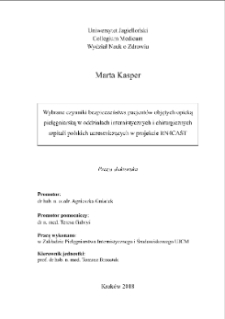Object
Title: Selected safety factors of patients under nursing care in the internal and surgical units of Polish hospitals participating in the RN4CAT project
Abstract:
Introduction Nurses, as the most numerous group of therapeutic team members, spend the most time with the patients. That is why the opinions of nurses as a professional group is taken into consideration when issuing a judgment on the safety of the patient, which was confirmed in international research and has become an inspiration for this research.Aim of the study: The purpose of the study is to assess the safety of patients under nursing care in internal and surgical units in Poland.Material and methods The study was based on the analysis of a part of the material collected for the RN4CAST project. The study involved thirty hospitals based on the institution's references, the number of nursing staff employed in internal and surgical units, and 24-hour medical duties. A questionnaire technique was used to obtain opinions in the nurse population and secondary data containing information on the organization and operation of the hospital. Statistically significant differences were treated with p <0.05.Results The study group consisted of 2605 nurses with 99.6% (n = 2580) of the study group being women with an average of 18 years of work experience 77.7% (n = 1942) of the women declared secondary education and 22.3% (n = 556) of the women had a university degree. There was no statistically significant relationship between the education of nurses and the assessment of patient safet ; y. 53% (n = 1375) of the nurses from this study group assessed the safety of patients at a rating of 3.1 on a scale from 1 to 5. It was confirmed that with the increase in the number of patients entrusted to the care of one nurse, the safety score of patients in the unit dropped significantly (τ-b = -0.10, p <0.001). Nurses admitted that due to lack of time they did not perform certain professional activities, and that also decreased the safety of patients (τ-b=-0,10; p<0,001). The greater the involvement of supervisors in the effort to ensure patient safety was a priority, the higher the nurses assessed patient safety (τ-b = 0.37, p <0.001).Conclusions The impact of the level of education on the assessment of patient safety has not been demonstrated. Lower patient safety assessments were closely related to the increase in the burden of non-professional activities and the increase in the number of activities not performed during nursing shifts. Frequent occurrence of adverse events as well as symptoms of burnout syndrome had a negative impact on patient safety.
Place of publishing:
Level of degree:
Degree discipline:
zdrowie publiczne ; pielęgniarstwo
Degree grantor:
Promoter:
Gniadek, Agnieszka ; Gabryś, Teresa
Date issued:
Identifier:
Call number:
Language:
Access rights:
Object collections:
Last modified:
Mar 13, 2023
In our library since:
May 2, 2019
Number of object content hits:
9
Number of object content views in PDF format
0
All available object's versions:
http://dl.cm-uj.krakow.pl:8080/publication/4274
Show description in RDF format:
Show description in OAI-PMH format:
| Edition name | Date |
|---|---|
| ZB-129206 | Mar 13, 2023 |
Objects
Similar
Kasper, Marta
Mikos, Marcin
Sowińska, Izabela
Andrychiewicz, Anna
Pękała,Aleksander (red tomu)
Pękała,Ryszard (red tomu)
Natkaniec, Michał

